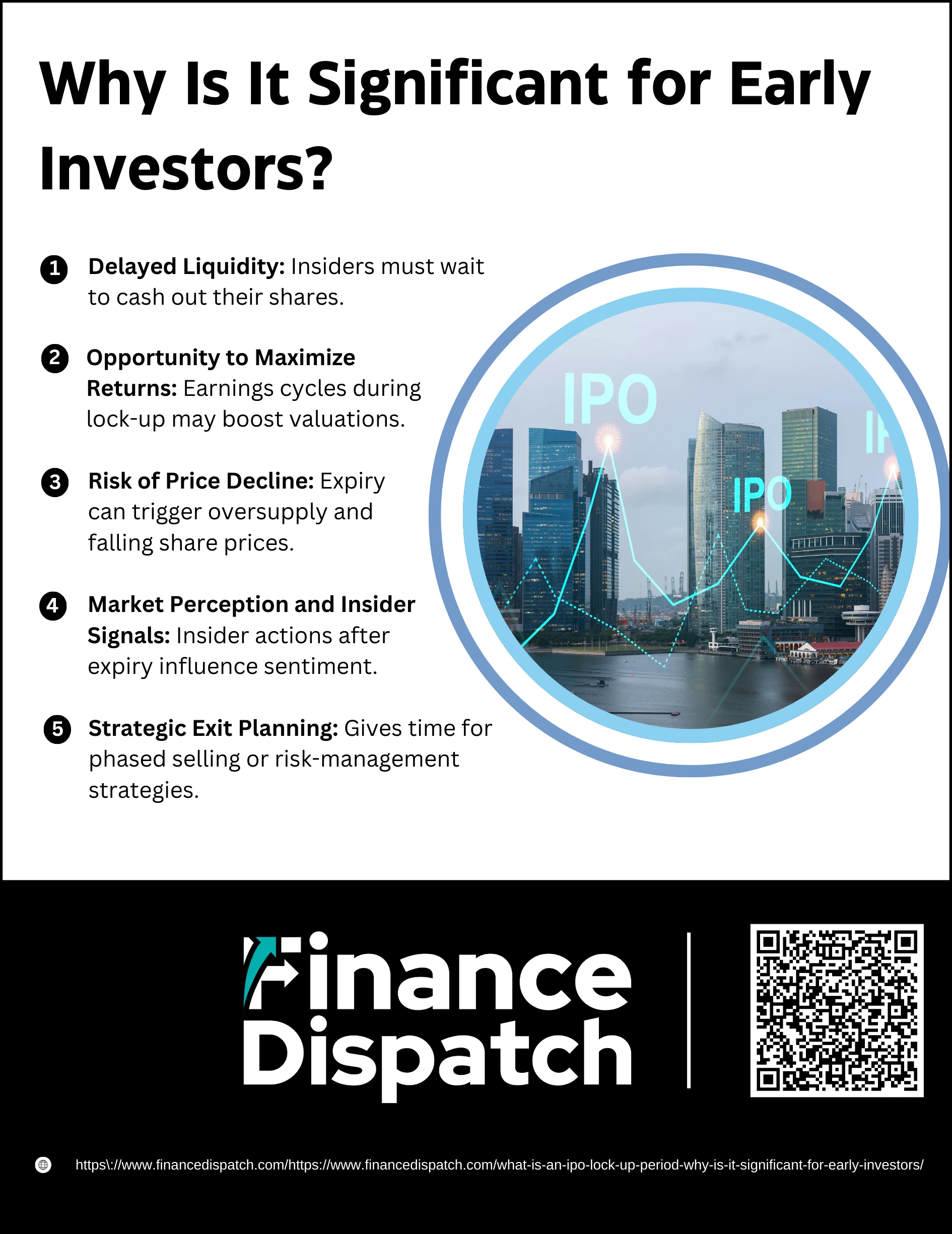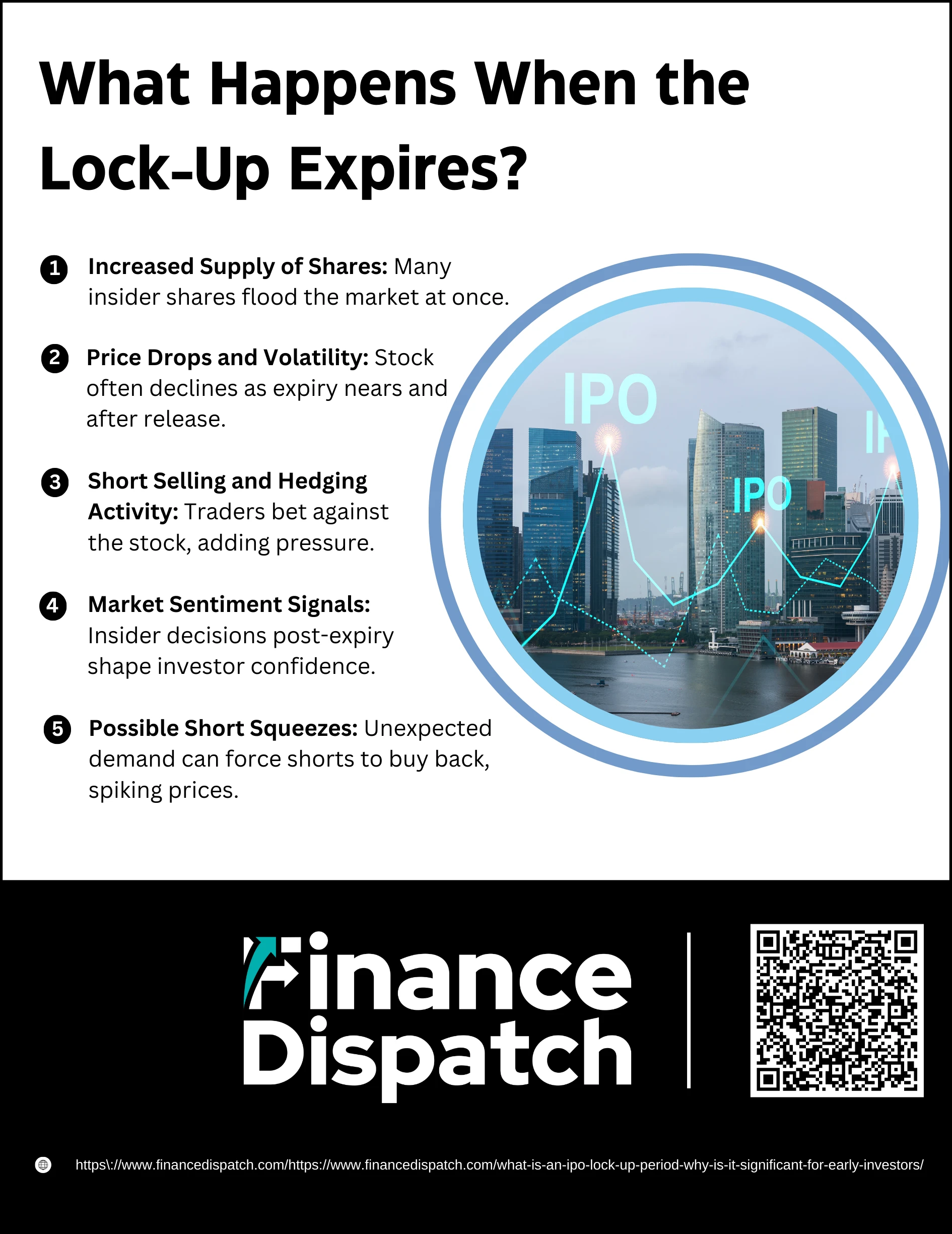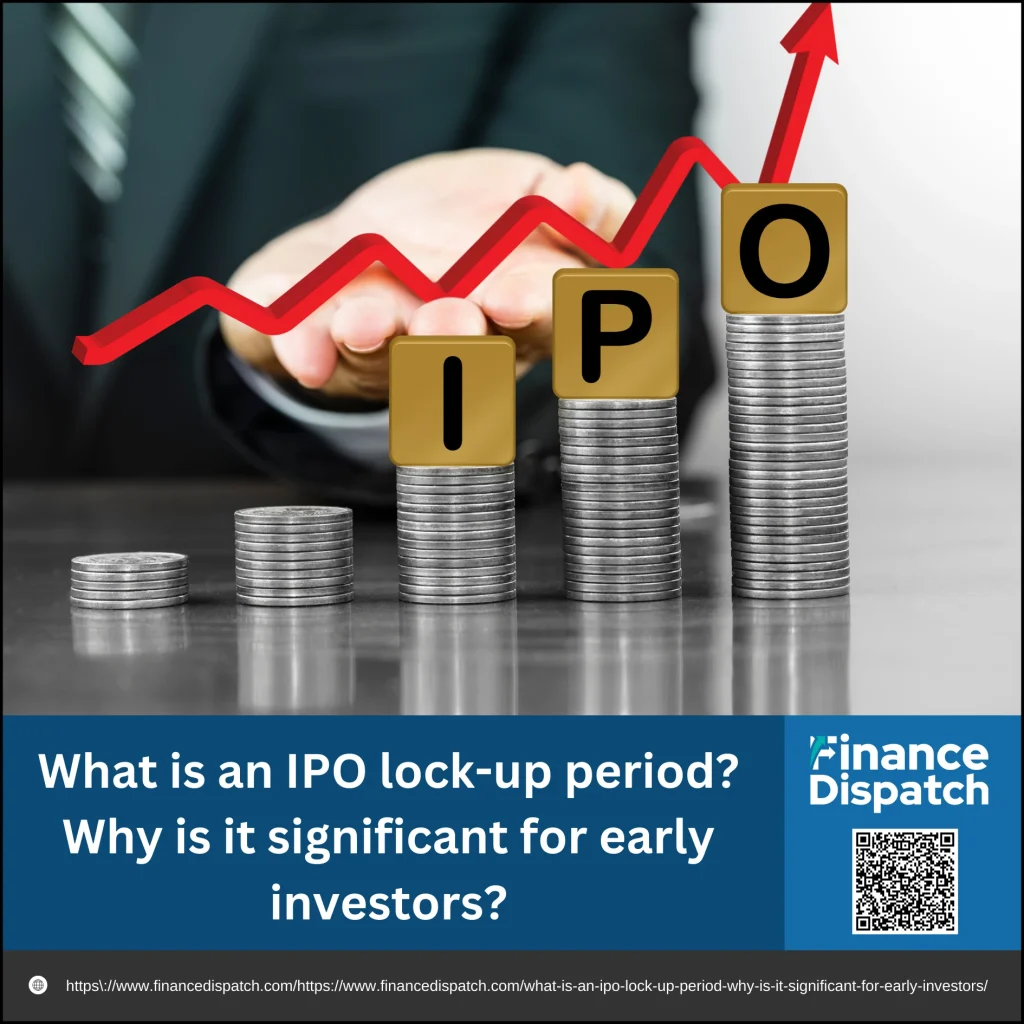When a company first goes public through an Initial Public Offering (IPO), it often sparks excitement among investors eager to participate in its growth story. Yet behind the headlines of soaring share prices and public listings lies a lesser-known but critical rule: the IPO lock-up period. This is a set timeframe during which company insiders—such as founders, executives, employees, and early backers—are restricted from selling their shares. The lock-up period plays a vital role in stabilizing the market during the early months of trading, ensuring that stock prices aren’t disrupted by a sudden wave of insider sell-offs. For early investors, understanding how this period works can make the difference between seizing an opportunity and facing unexpected risks.
What Is an IPO Lock-Up Period?
An IPO lock-up period is a predetermined stretch of time after a company goes public during which certain shareholders are restricted from selling their shares. These shareholders usually include company insiders such as founders, executives, employees, and early investors who hold a significant portion of stock. The lock-up typically lasts between 90 and 180 days, though in some cases—such as with SPACs or promoter holdings—it may extend longer. During this period, shares are essentially “frozen” to prevent a sudden flood of supply that could push down the stock price. The agreement is not mandated by regulators like the SEC but is usually set between the company and its underwriters as a way to support stability and give the market time to determine a fair value for the new stock.
 Purpose of the Lock-Up Period
Purpose of the Lock-Up Period
The lock-up period is designed to protect both the company and its investors in the sensitive months following an IPO. Without such restrictions, insiders selling their large holdings immediately could cause sharp declines in the stock price and damage trust in the company’s prospects. Below are the key purposes explained in detail:
1. Preventing Market Flooding
When a company goes public, only a fraction of its shares are initially available to the public. If insiders were allowed to sell massive amounts of stock right away, it would suddenly increase supply. Too much supply against limited demand could overwhelm the market and trigger a steep price drop. The lock-up prevents this by gradually phasing in new shares.
2. Stabilizing Stock Price
A sudden sell-off by insiders could create unnecessary volatility in the stock’s early trading days. By holding back these shares, the lock-up helps balance supply and demand, allowing the price to move in a more orderly fashion. This is especially important because investors are still evaluating the company’s performance and financial health in its first few quarters.
3. Building Investor Confidence
A lock-up period signals that company insiders believe in the long-term value of their business. If they were to sell immediately, it could be seen as a lack of faith in the company’s future. By staying invested for a set time, insiders demonstrate commitment, which reassures new retail investors and institutions alike.
4. Allowing Natural Price Discovery
After an IPO, the market needs time to determine the stock’s true value based on business performance, earnings reports, and investor sentiment. Lock-ups create a “cooling-off” phase where prices adjust naturally without artificial pressure from insider selling. This helps ensure that when shares eventually become available, the price reflects a more accurate valuation.
5. Protecting Retail Investors
New individual investors are often the most vulnerable to sudden price swings. If insiders offloaded their shares immediately, retail investors could face steep losses within days or weeks of buying in. Lock-ups provide a safeguard, giving retail participants a fairer chance to assess the company without the risk of immediate insider dumping.
 Why Is It Significant for Early Investors?
Why Is It Significant for Early Investors?
For early investors, the IPO lock-up period is more than a waiting game. It directly impacts how and when they can convert their investment into cash, while also shaping the broader market’s perception of the company’s stability. Below are the main reasons why this period is significant, explained in detail:
1. Delayed Liquidity
Early investors—whether they are founders, employees, or venture capitalists—often hold a large chunk of shares that represent years of work or funding. The lock-up restricts them from selling right after the IPO, meaning their wealth remains “on paper” until the restriction ends. While this delay helps stabilize the stock, it can create personal challenges for insiders who may have immediate financial needs or plans for reinvestment.
2. Opportunity to Maximize Returns
Although the waiting period may feel restrictive, it can actually work in favor of early investors. During the lock-up, the company usually has time to report one or two earnings cycles, which can provide proof of its growth potential. If results are positive, market confidence strengthens, and share prices may hold steady or even climb—giving insiders a chance to exit later at a stronger valuation.
3. Risk of Price Decline
On the flip side, once the lock-up expires, a flood of new shares may hit the market as insiders look to sell. This sudden oversupply often drives prices lower. For early investors, this means that their shares could end up being worth significantly less than the IPO price or the trading highs in the first weeks after listing. Timing becomes critical, and many insiders must weigh whether to sell quickly or hold longer.
4. Market Perception and Insider Signals
The behavior of insiders at the end of the lock-up is closely monitored by analysts and retail investors. If insiders immediately dump their shares, it may be interpreted as a lack of confidence in the company’s long-term prospects. On the other hand, if insiders choose to hold on, it signals belief in future growth and can help sustain market trust. In this sense, insiders’ actions serve as powerful signals that can influence both sentiment and stock performance.
5. Strategic Exit Planning
The lock-up period gives early investors time to craft a smart exit plan. Some may sell in phases to avoid overwhelming the market, while others might use financial tools such as hedging or collars to manage risks around expiration. Planning ahead allows them to balance personal liquidity needs with the broader impact on stock prices, and in many cases, a gradual strategy helps minimize volatility while preserving long-term value.
How Long Do Lock-Up Periods Last?
The duration of an IPO lock-up period typically falls between 90 and 180 days, though the exact length depends on agreements between the company and its underwriters. In some cases—such as with promoters, SPAC sponsors, or anchor investors—the restriction may extend much longer. These timelines are designed to balance the interests of insiders who want liquidity and the need to protect market stability.
Common Lock-Up Durations by Stakeholder
| Stakeholder | Typical Duration | Reason/Purpose |
| Founders & Promoters | 6 – 18 months | Ensures long-term commitment and confidence in company’s future |
| Executives & Employees | 90 – 180 days | Prevents mass liquidation of shares received via compensation |
| Early Investors (VCs, PE funds) | ~6 months | Encourages a phased exit without destabilizing the market |
| Anchor Investors | 30 – 90 days (varies) | Signals confidence to new investors during IPO launch |
| SPAC Sponsors/Insiders | 6 – 12 months (sometimes longer) | Aligns sponsor interests with public investors during merger transition |
 What Happens When the Lock-Up Expires?
What Happens When the Lock-Up Expires?
The end of a lock-up period is a critical moment for both insiders and public investors. It often brings significant trading activity because a large number of previously restricted shares become available. The impact, however, can vary—sometimes it triggers sell-offs and volatility, while other times it creates buying opportunities. Here’s a closer look at the typical outcomes:
1. Increased Supply of Shares
Once the lock-up expires, insiders such as founders, employees, and early investors can finally sell their shares. This sudden release of supply can overwhelm demand, especially if millions of shares hit the market at once. For example, when Facebook’s first lock-up ended in 2012, the market was flooded with hundreds of millions of shares, leading to a significant price decline.
2. Price Drops and Volatility
Because of the anticipated surge in supply, stock prices often begin to slide days before the actual expiry. Investors expect insiders to sell, and that expectation alone can drive the price down. Once the shares are unlocked, volatility increases as markets adjust to the new equilibrium. In some cases, the price decline is temporary, but in others it can mark a more sustained drop.
3. Short Selling and Hedging Activity
Traders frequently use the lock-up expiry as an opportunity to profit from expected price declines. They may short-sell the stock in advance, betting on a dip. At the same time, some institutional investors hedge their long positions with options to protect themselves against potential losses. This activity adds another layer of pressure to the stock around expiry.
4. Market Sentiment Signals
How insiders act after the lock-up is closely monitored. If many insiders sell immediately, it may signal a lack of confidence in the company’s long-term future, which can further depress the price. On the other hand, if insiders hold on, it reassures outside investors that those closest to the business still believe in its growth. In this way, insider behavior acts as a powerful signal to the broader market.
5. Possible Short Squeezes
Sometimes, expectations of a sell-off are so widely held that too many traders short the stock. If the selling pressure doesn’t materialize—or if demand for shares suddenly spikes—short sellers may be forced to buy back shares quickly to cover their positions. This creates a “short squeeze,” driving the stock price sharply upward instead of down. A famous example occurred with Shake Shack in 2015, when its stock price jumped more than 30% after its first lock-up expiration, catching short sellers off guard.
Strategies for Investors Around Lock-Up Periods
For investors, IPO lock-up periods can create both risks and opportunities. While the release of insider shares often leads to price drops and volatility, it can also present chances to enter at a lower cost or protect gains with smart planning. By monitoring key dates and understanding market behavior, investors can make better-informed decisions around these events.
Practical strategies include:
1. Check the prospectus – Review the IPO prospectus (S-1 filing) to learn when lock-up restrictions expire and how many shares will be released.
2. Wait for the expiry dip – Consider buying after the lock-up ends, when a potential sell-off may temporarily push prices down.
3. Monitor early waivers – Watch for underwriters granting insiders permission to sell before the official expiry, as this can affect supply sooner than expected.
4. Track insider activity – Observe whether founders, executives, or large investors are holding or selling after expiry, as this signals confidence—or doubt—in the company’s future.
5. Use hedging tools – Investors holding large positions can protect against post-expiry drops with strategies like options, collars, or stop-loss orders.
6. Stay alert to market trends – Broader market sentiment can amplify lock-up effects, so align your strategy with the overall environment.
Special Case: SPAC Lock-Ups
Special Purpose Acquisition Companies (SPACs) follow a different timeline compared to traditional IPOs. After a SPAC goes public, it generally has up to two years to identify and merge with a target company. The sponsors and insiders of the SPAC are typically required to hold their shares for a longer period—often six to twelve months after the merger is completed—before they can sell. This extended lock-up is designed to align the interests of the SPAC sponsors with those of new public investors and to provide stability as the newly combined company transitions into regular trading.
Risks and Limitations of Lock-Ups
While IPO lock-up periods are designed to stabilize markets and protect new investors, they are not without drawbacks. For insiders, they can create financial constraints, and for the market, they may distort the real demand for a company’s shares. Understanding these risks helps investors see the full picture beyond the benefits.
Key risks and limitations include:
1. Liquidity crunch for insiders – Founders, employees, and early investors may struggle to access cash since they are unable to sell their shares during the lock-up.
2. False sense of demand – With shares artificially restricted, the market may appear stronger than it really is, creating a misleading view of investor interest.
3. Price decline after expiry – Once restrictions lift, a sudden surge of selling can push stock prices down sharply.
4. Opportunity cost – Early investors may miss out on reinvesting their capital elsewhere while their money remains locked in shares.
5. Margin and collateral risks – If insiders pledged shares as collateral before the IPO, they could face margin calls if prices fall during or after the lock-up.
6. Overhang effect on sentiment – Awareness of an upcoming unlock can cap share price rallies weeks in advance, as the market braces for insider selling.
Conclusion
The IPO lock-up period is more than just a technical detail—it’s a safeguard that shapes the early trading journey of a newly public company. By temporarily restricting insiders from selling, it helps stabilize share prices, reassures new investors, and allows the market time to discover the stock’s fair value. At the same time, it carries challenges, such as liquidity constraints for insiders and potential price drops once the restriction ends. For early investors and retail participants alike, understanding lock-up periods is essential. Tracking expiration dates, watching insider behavior, and preparing for volatility can turn these events into opportunities rather than surprises.



